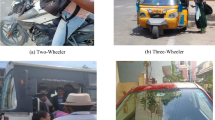Abstract
Acceleration and deceleration are amongst the vehicular characteristics, which are both time dependent and location dependent. The present study aims to quantify the variation in acceleration and deceleration characteristics at manually operated toll plaza under mixed traffic conditions. The field data collected for seven different vehicle categories observed at Ghoti toll plaza using global position system based P-box survey. The discretization of speed profile technique was developed and used for evaluation of acceleration and deceleration values in Zone of Influence (ZOI) precisely. The results of descriptive statistics showed that the ZOI for toll plaza was about 500 m totally with 250 m in upstream and 250 m in downstream. The speed versus distance and acceleration/deceleration versus distance plots were plotted and regression analysis was carried out for finding out relation. One-way analysis of variance test was also performed to check whether the significant difference exist between the acceleration/deceleration values for each section and within the section for all seven categories. It was found that the second-degree polynomial equation was best fit for both acceleration and deceleration with respect to distance. Accuracy of the developed model was checked using the t statistics.












Similar content being viewed by others
References
Jose R, Mitra S (2018) Identifying and classifying highway bottlenecks based on spatial and temporal variation of speed. J Transp Eng Part A Syst 144:1–12. https://doi.org/10.1061/JTEPBS.0000183
Bokare PS, Maurya AK (2017) Acceleration–deceleration behaviour of various vehicle types. Transp Res Procedia 25:4733–4749. https://doi.org/10.1016/j.trpro.2017.05.486
Edie LC (1954) Traffic delay at toll booths. J Oper Res Soc Am 2:107–138
Mousa RM (2002) Analysis and modeling of measured delays at isolated signalized intersections. J Transp Eng ASCE 128:347–354
Ahn K, Rakha H, Trani A, Van AM (2002) Estimating vehicle fuel consumption and emissions based on instantaneous speed and acceleration levels. J Transp Eng ASCE 128:182–190
Wang J, Dixon KK, Li H, Ogle J (2004) Normal acceleration behavior of passenger vehicles starting from rest at all-way stop-controlled intersections. Transp Res Rec J Transp Res Board, Washington, DC 1883:158–166
Wang J, Dixon KK, Li H, Ogle J (2005) Normal deceleration behavior of passenger vehicles at stop sign—controlled intersections evaluated with in-vehicle global positioning system data. Transp Res Rec J Transp Res Board, Washington, DC 1937:120–127
Ozmen-Ertekin D, Ozbay K, Mudigonda S, Cochran AM (2008) Simple approach to estimating changes in toll plaza delays. Transp Res Rec J Transp Res Board, Washington, DC 2047:66–74. https://doi.org/10.3141/2047-08
Aycin M, Kiskel K, Papayannoulis V, Davies G (2009) Development of methodology for toll plaza delay estimation for use in travel demand model postprocessor. Transp Res Rec J Transp Res Board 2133:1–10. https://doi.org/10.3141/2133-01
Yang G, Xu H, Tian Z, Wang Z (2016) Vehicle speed and acceleration profile study for metered on-ramps in California. J Transp Eng ASCE 142:1–13. https://doi.org/10.1061/(ASCE)TE.1943-5436.0000817
Mehar A, Chandra S, Velmurugan S (2013) Speed and acceleration characteristics of different types of vehicles on multi-lane highways. Eur Transp Trasp Eur 55:1–12
Galgamuwa U, Perera L, Bandara S (2016) A representative driving cycle for the southern expressway compared to existing driving cycles. Transp Dev Econ 2:1–8. https://doi.org/10.1007/s40890-016-0027-4
Nama S, Maurya AK, Maji A et al (2016) Vehicle speed characteristics and alignment design consistency for mountainous roads. Transp Dev Econ 2:1–11. https://doi.org/10.1007/s40890-016-0028-3
Indian Roads Congress (IRC) SP:84 (2014) Manual of specifications and standards for four laning of highways through public private partnership
Weng J, Wang R, Wang M, Rong J (2015) Fuel consumption and vehicle emission models for evaluating environmental impacts of the ETC system. Sustain MDPI. https://doi.org/10.3390/su7078934
Yan Y, Ye Z, Wang C, Zhu J (2017) Vehicle emission comparisons along electronic and manual toll collection lanes. CICTP 2017:3042–3058
Racelogic Limited (2014) Performance Box-III 100Hz GPS data logger user guide. 1–74
Bari CS, Navandar YV, Dhamaniya A (2020) Vehicular emission modeling at toll plaza using performance box data. J Hazard Toxic Radioact Waste 24:1–19. https://doi.org/10.1061/(ASCE)HZ.2153-5515.0000550
Yang G, Wang Z, Xu H, Tian Z (2018) Feasibility of using a constant acceleration rate for freeway entrance ramp acceleration lane length design. J Transp Eng Part A Syst ASCE 144:1–8. https://doi.org/10.1061/JTEPBS.0000122
Chung Y, Choi Y-H, Yoon B-J (2017) Safe operation guidelines for electronic toll collection systems: a case study in Korea. Int J Civ Eng. https://doi.org/10.1007/s40999-016-0129-8
Zarrillo ML, Radwan EA (2009) Methodology SHAKER and the capacity analysis of five toll plazas. J Transp Eng 135:83–93
Russo C, Harb R, Radwan E (2010) Calibration and verification of SHAKER, a deterministic toll plaza simulation model. J Transp Eng ASCE 136:85–92. https://doi.org/10.1061/(ASCE)TE.1943-5436.0000060
Arasan VT, Koshy RZ (2005) Methodology for modeling highly heterogeneous traffic flow. J Transp Eng ASCE 131:544–551
Polus A, Livneh M, Factor J (1985) Vehicle flow characteristics on acceleration lanes. J Transp Eng ASCE 111:595–606
Acknowledgements
The authors acknowledge the opportunity to submit the research work at the 5th Conference of the Transportation Research Group of India held at Bhopal (India) from 18–21 December 2019, that forms the basis of this article.
Author information
Authors and Affiliations
Corresponding author
Additional information
Publisher's Note
Springer Nature remains neutral with regard to jurisdictional claims in published maps and institutional affiliations.
Rights and permissions
About this article
Cite this article
Bari, C.S., Navandar, Y.V. & Dhamaniya, A. Analysis of Vehicle Specific Acceleration and Deceleration Characteristics at Toll Plazas in India. Transp. in Dev. Econ. 7, 4 (2021). https://doi.org/10.1007/s40890-021-00115-6
Received:
Accepted:
Published:
DOI: https://doi.org/10.1007/s40890-021-00115-6




